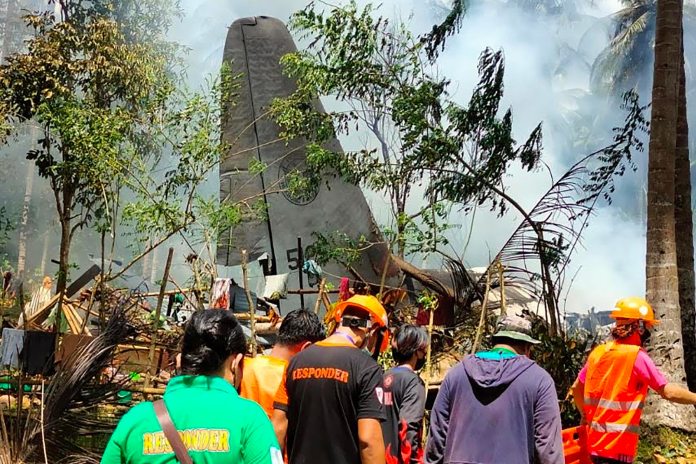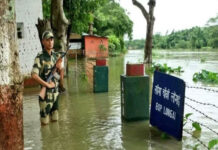Philippine troops found the last five people dead after a transport plane crashed in the south, raising the death toll in the army’s worst air disaster to 50, officials said Monday.
Military officials said a Lockheed C-130 Hercules 96 was carrying mostly combat troops when it overtook the runway when it landed at Jolo airport in Sulu province on Sunday. It crashed into a coconut orchard outside the airport and engulfed in flames in an afternoon disaster witnessed by terrifying soldiers and villagers.
Soldiers, police and firefighters rescued 49 military personnel, some of whom jumped off the plane and were burned by fire before it exploded. The army said seven people on the ground were hit by aircraft parts and debris, and three of them died.
The Lockheed C-130 Hercules was one of two refurbished US Air Force aircraft handed over to the Philippines, Washington’s oldest treaty ally in Asia, this year as part of military aid.
The plane had earlier flown two-star General Romeo Brower Jr., his wife and three children from Manila to the southern city of Cagayan de Oro, where he is set to become the new military regional commander on Monday.
Those who boarded the C-130 at Cagayan de Oro for the flight to Sulu were Army soldiers, many of them newly trained recruits, to be deployed to the south against Abu Sayyaf militants.
Bronner was stunned to learn that the plane he was flying on had crashed. “We are very grateful that we were spared, but it is extremely sad that so many people lost their lives,” Bronner told the Associated Press.
A video taken by soldiers showed the plane landing in clear weather and then disappearing outside the airport. “It disappeared, it disappeared,” said one soldier. Dark brown smoke later erupted from the crash site in a wooded area, when soldiers shouted, “It fell, it fell” and let out a terrifying curse.
“He was about to join us in our fight against terrorism,” said Sulu military commander Major General William Gonzales. Government forces in the Muslim-majority province of Sulu have been battling Abu Sayyaf’s extremists for decades.
It was not immediately clear what caused the crash and investigators were looking for the C-130’s black box that contained the cockpit voice and flight data recorders.
The regional military commander, Lieutenant General Corletto Vinluan, said it was unlikely the plane fired hostile fire. Military chief General Sirilito Sobejana told reporters on Sunday that “the plane missed the runway and was trying to regain power but failed and crashed.”
An Air Force official told the AP that the Jolo runway is shorter than other runways in the country, making it more difficult for pilots to adjust if an aircraft misses a landing spot. The officer, who has flown military aircraft from Xolo several times, spoke on condition of anonymity due to lack of rights to speak publicly.
President Rodrigo Duterte expanded the military presence in Sulu to a full division in late 2018, deploying hundreds of additional troops, air force planes and other combat equipment after vowing to wipe out Abu Sayyaf. The small but brutal group has been blacklisted by the US and the Philippines as a terrorist organization for ransom kidnappings, bombings and beheadings.
Military historian Jose Custodio said that before Sunday, the Philippine Air Force’s deadliest disaster was an accident in a rice field north of Manila in 1971 that killed 40 military personnel.
The recently delivered S-701 Blackhawk helicopter crashed more than a week ago near Clark Freeport, a former US airport, killing all six Air Force personnel.
The Philippine government has struggled for years to modernize its military, which is one of Asia’s least equipped, as it deals with decades-long Muslim and communist rebels and territorial rifts with China and other claimant nations in the South China Sea. is.


















































